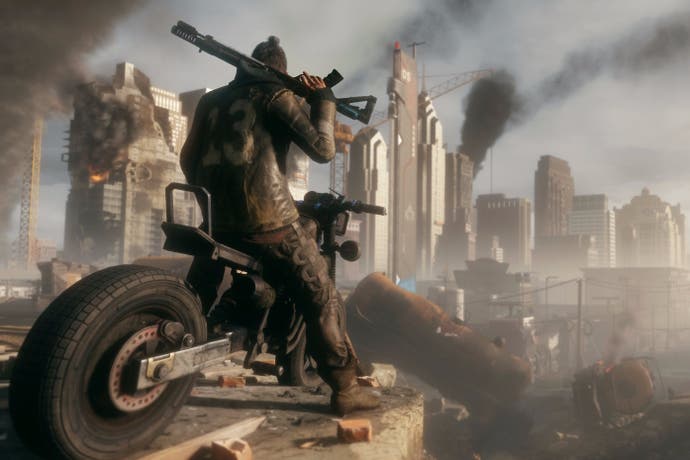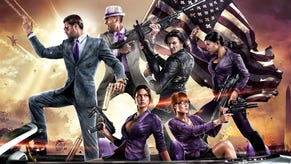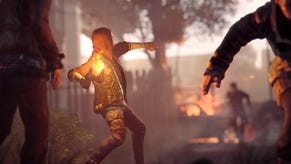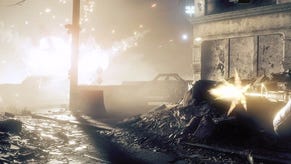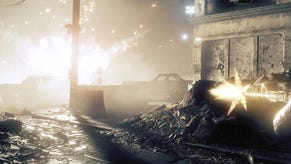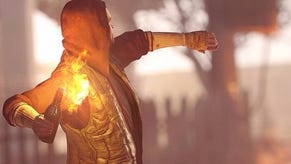Homefront: The Revolution is already a big improvement on the original
New gameplay and new impressions of Dambuster Studio's sequel.
THQ and Kaos Studios' Homefront was certainly interesting. Taking a premise co-opted from John Milius' Red Dawn - and Milius helped with the scenario on the game, perhaps - its redneck fantasy of an America invaded by Korean militia had a gritty, homespun appeal. Homefront did reasonably well - coming out when Call of Duty fever was at a high, a timely release date away from the Q4 churn helped it shift in excess of two million units - and THQ saw enough potential in its set-up to fast-track a sequel.
The only thing is, Homefront wasn't a very good game.
Five years on, and after an often turbulent development, the people behind that sequel would probably tell you just as much. "Homefront's interesting in what it did, what it executed on, and what it didn't," says Deep Silver Dambuster Studios' head and Homefront: The Revolution's director Hasit Zala. You sense that with the dictaphone turned off and with the PR out of the room, he might be more blunt in his appraisal. As it is, he remains politely diplomatic.
"As an IP, as a concept and as a vision it really resonated. As a product, I think it fell short. If I'm allowed to just kind of echo the sentiments of Metacritic, and critical feedback. From our point of view, yes it's been a while. But in many ways we don't see ourselves making a sequel. We had the IP, we had the conceit, and even the whole backstory is something we've reinvented, and it's a rebirth of the IP for us. But we've also got this bedded in understanding of what the concept is."
That concept's at the heart of Homefront: The Revolution, but this time out the fiction's been a little more thoughtfully applied to the rest of the world and, most importantly, to the game itself. You're part of a small resistance force fighting in an occupied Philadelphia, taking back this vast, murky open world one strike point at a time as you wrestle back control.
So far so Far Cry, you might think, and that's fair enough. Credit where it's due, though: this is a more brutal, more oppressive open world than the colourful jungle canopies of Ubisoft's open world shooter, and from 40 minutes spent in its gloom, the sense of conquest it engenders is uniquely satisfying.

Part of that's down to the open world itself, a dense nest of abandoned warehouses and scattershot corrugated iron piecing together broken brickwork. Destroyed beauty isn't exactly a concept new to games, but it's rarely been as beautiful as this: CryEngine helps infuse the city with beaten down life and light as the day/night cycle works through its rotations, puddles forming in the cracked concrete streets as weather fronts move in. The high concept, the development team says, is an open world Half Life 2, and in the squalor of Homefront: The Revolution's Philadelphia you can see so much of City 17.
You'll sense some of that influence in the encounters that are more tense, and more testing, than most modern-day shooter fare. It's billed as asymmetric warfare, with the kicker being you're on the wrong end of that asymmetry, going up against a tooled-up Korean army equipped with darting drone scouts and airships that lazily float overhead with nothing but a bag of homebrew goodies and a gun that's seemingly held together by gaffer tape.
What you do have, though, is flexibility and wit. The gun's components can be easily swapped out, allowing you to go from a straight assault rifle to a DIY deathstick that spits out incendiary rounds. Complementing that is your Guerrilla Tool Kit - or GTK, as it's referred to - which gives you ready access IEDs, hacking devices that can turn an APC against its own troops and firecrackers that will help distract a patrol. There are options within those options, even - those IEDs can be placed on a wall and detonated remotely, simply lobbed in the desired direction or, for those with a little more class, placed on a remote control car and driven into the fray.

The result is a strongly systemic game, where the open world is patrolled by troops with a neat sense of emergent behaviour, and where you're given the tools to take them down how you please. In our brief time with Homefront: The Revolution, the behaviour that emerges mainly tells of an enemy that's tough as nails; snipers sit at every corner, and it's a case of inching your way out, darting between cover before scrambling up behind them to take them out. Even when they've been dealt with, it's unwise to take on a patrol with more than a couple of soldiers, the wiser option being to pick them off one by one or, even better, simply stay out of their sights.
That tension will likely evolve over the course of Homefront: The Revolution, and it's still open to tweaks. The open world itself promises to introduce some crinkles, too, split into three distinct zones with one of them representing standalone, story focused missions that'll break up the more freeform bulk of the game. There's multiplayer, too, in a four player co-op mode that sits separately from the campaign, although there's not much in the way of detail on that for now. Neither is there anything on more traditional PvP - and given Dambuster Studio's heritage, with Crysis' multiplayer as well as TimeSplitters in its DNA, you'd hope it's going to feature in some way.
Those details will likely be drip-fed throughout the months leading up to Homefront: The Revolution's release. It's looking likely for release some time next year, though Deep Silver and Dambuster won't say much beyond that. Still, six years on from the original the wait could well be worth it, and that premise might finally be able to live up to its promise.
